Kia ora and welcome to the Spring 2019 update from the Transmission Gully team.
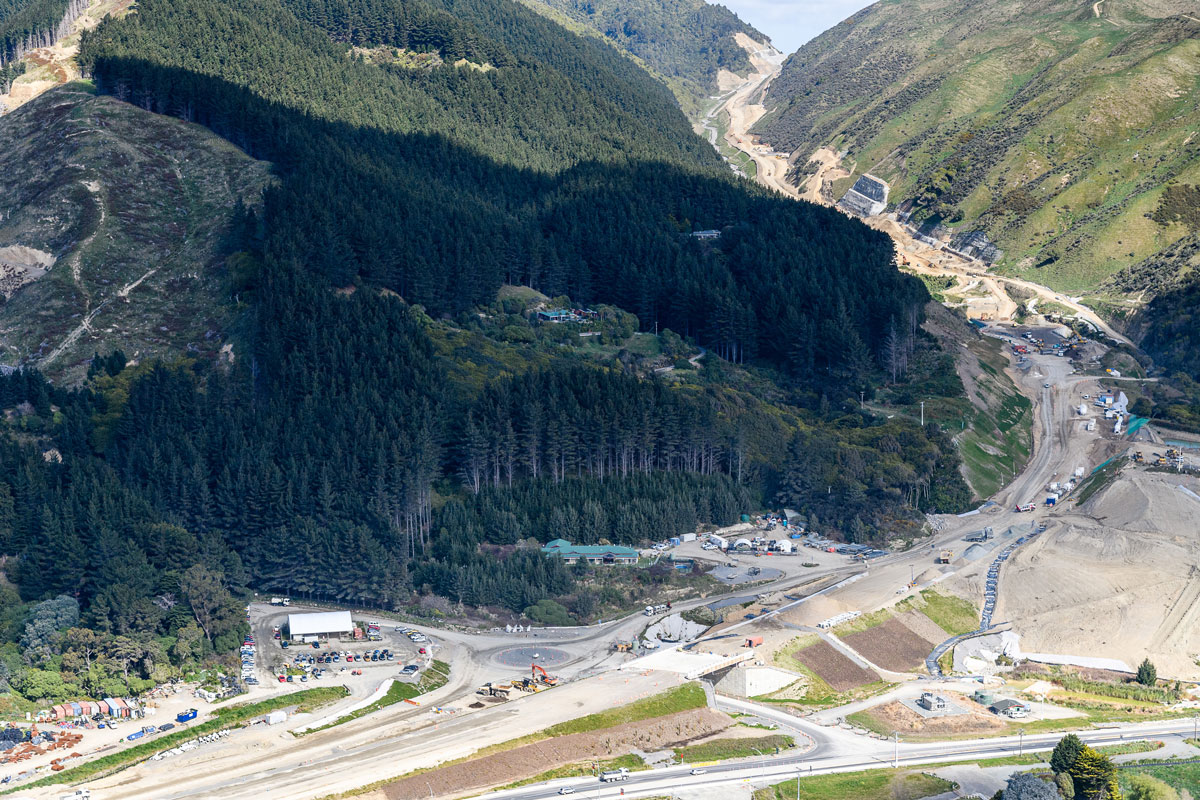
An aerial view looking east over the new motorway taking shape through the Wainui Saddle.
On Thursday 29 August 2019, the NZ Transport Agency announced that the Transmission Gully motorway will not be tolled.
It is the Transport Agency’s policy to assess all new state highway projects for tolling feasibility.
Since March 2018, the Transport Agency has been assessing the feasibility of tolling Transmission Gully against a number of criteria, including the impact that tolling might have on road users, the transport system and local communities.
When considering whether tolling would be appropriate, the Transport Agency needed to weigh the potential revenue benefits against the impact of tolling on safety, access and value for money.
As Transmission Gully is delivered under a Public Private Partnership, the decision to not toll Transmission Gully does not have any implications on the cost to construct, operate and maintain the new motorway.
Media release announcing decision not to toll Transmission Gully
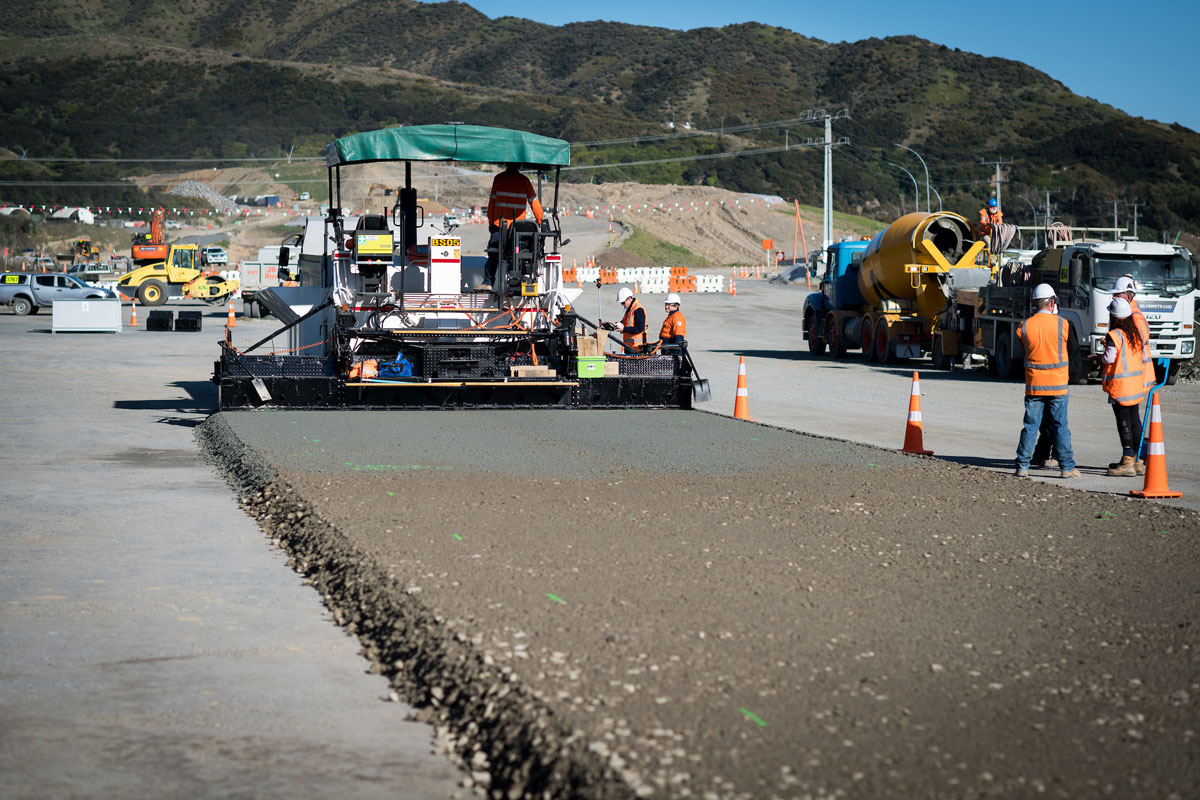
The project’s new gravel paving machine hard at work on a section of the new motorway at Paekākāriki.
The top layer or ‘pavement’ of the Transmission Gully motorway is now under construction.
“Building a quality road surface on the scale required for the Transmission Gully motorway is a complex task says Wellington Gateway Partnership’s CEO, Sergio Mejia. “It’s not just about the sheer volume of material that’s needed to build up the structured layers that form the roading surface, but also the precision required to achieve consistency in these layers across the length of the route.”
‘Pavement’ in this context refers to the structural layers of the road, which are typically made up of gravel of specifically graduated dimensions, with a waterproof seal on top. All together these layers form a tight matrix that provides strength and prevents the entry of water to the pavement. The 27-kilometre-long motorway, which predominantly runs through a rural setting, will include various pavement and sealing types. Most of the route will be sealed with chip seal, which is the most common type of road surface in New Zealand. Rural roads most often have one coat of chip seal and motorways generally have multiple coats, which will be the case for the Transmission Gully motorway. The additional coats improve the smoothness of the surface and reduce tyre noise.”
At the southern end of the motorway structural asphalt will be used to tie into the existing motorway and provide some noise benefits to residents that are very close to the motorway in the urban areas of Linden and Tawa.
On completion, the 27km-long motorway will include various pavement configurations to meet various roading requirements. However, the basic standard is that the first layer or ‘subbase’ must be blended aggregate that all passes through a 65mm screen, that is termed ‘All Passing’ or ‘AP 65’. The next layer is the ‘base course’, which is constructed with ‘AP 40’ which is blended rock that all passes through a 40mm screen.
Over 700,000 tonnes of surfacing material (quarried rock product) is needed for the motorway pavement. To prevent exhausting supplies around the lower North Island for other projects, the old Willowbank Quarry on State Highway 58 is being reopened to source many of these materials.
Once the Willowbank Quarry is operational, sourcing this pavement material locally will be cost effective and minimise transport impacts on other road users.
Following the motorway’s opening next year, responsibility for ensuring the pavement remains in tip top condition rests with Ventia, contracted by the Wellington Gateway Partnership to provide Operations and Maintenance services for the Transmission Gully motorway for the next 25 years.
Ventia is one the largest infrastructure service providers in Australasia and we’ll share more about Ventia and what’s planned for the operations and maintenance of the new Transmission Gully motorway over the next 25 years, in the next edition of our project newsletter.
A large Gravel Paving machine, shipped from Australia in July, is proving its worth on the project by increasing efficiency and assisting in quality control for paving works.
As we move closer to opening the new motorway, and the interchanges start to take shape, we’ll take a closer look at each. A spotlight on Kenepuru is the first in a series of information articles to give road users details on how the interchanges will work.
Finishing works have begun in the Kenepuru and Linden areas; one of the most complex sections of the Transmission Gully motorway project.
In this area the construction team has been challenged to build a new motorway around an older one while keeping State Highway 1 open to traffic. It’s also involved working very close to suburban streets and local businesses. The large northbound bridge to access the new motorway, Kenepuru link road bridge and new Collins Avenue overbridge are all on track and in the final stages of construction.
Preparatory works for the Kenepuru Drive roundabout are underway where we’re building up ground levels to meet up and tie into the local road. This work will start to interface with local road users later in the year, and will involve some temporary traffic management measures. When we are close to starting these works, we’ll update the community on the plans to keep local traffic moving as smoothly as possible. Pedestrians will be provided for as well. Works in the area will be ongoing until the end of the year, to keep us on schedule to open the new motorway in 2020.
Here’s how the different bridges and roundabouts work together to form the new Kenepuru Interchange.
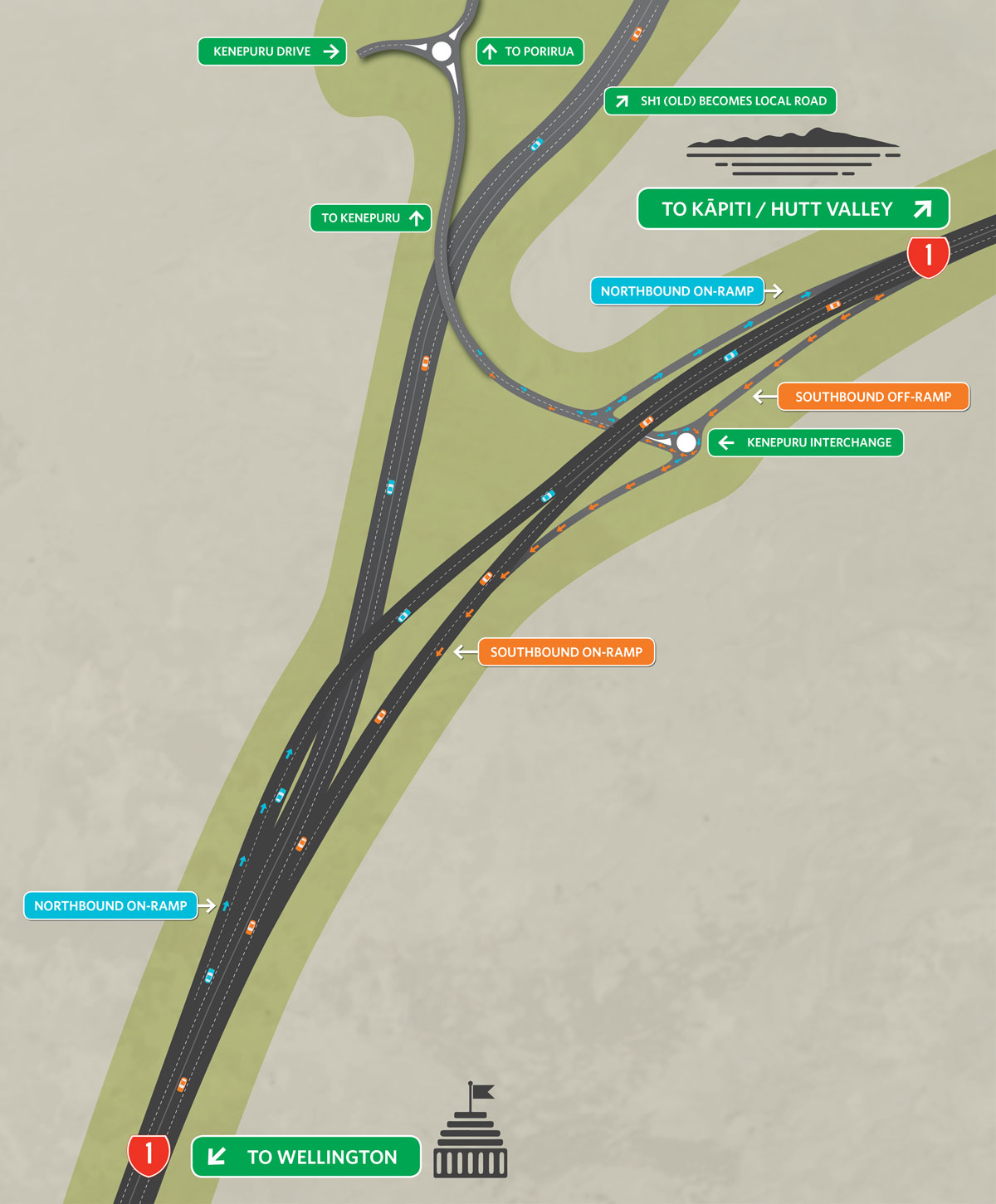
Map view of the Kenepuru Interchange.
Northbound traffic will have two choices when approaching the new Kenepuru Interchange. The existing two northbound lanes will widen to three lanes south of the interchange and then traffic will split across four lanes at the interchange, in the same way that SH1 and SH2 split at Ngauranga. The two left-lanes will carry traffic seamlessly onto the new motorway, while the two right-lanes will carry traffic towards Porirua, Plimmerton and other northern suburbs via the existing SH1 network of interchanges and local roads.

Map view of the new northbound flyover onto the Transmission Gully motorway.
Northbound traffic on Kenepuru Drive will have two choices when they reach the new Kenepuru Drive roundabout.
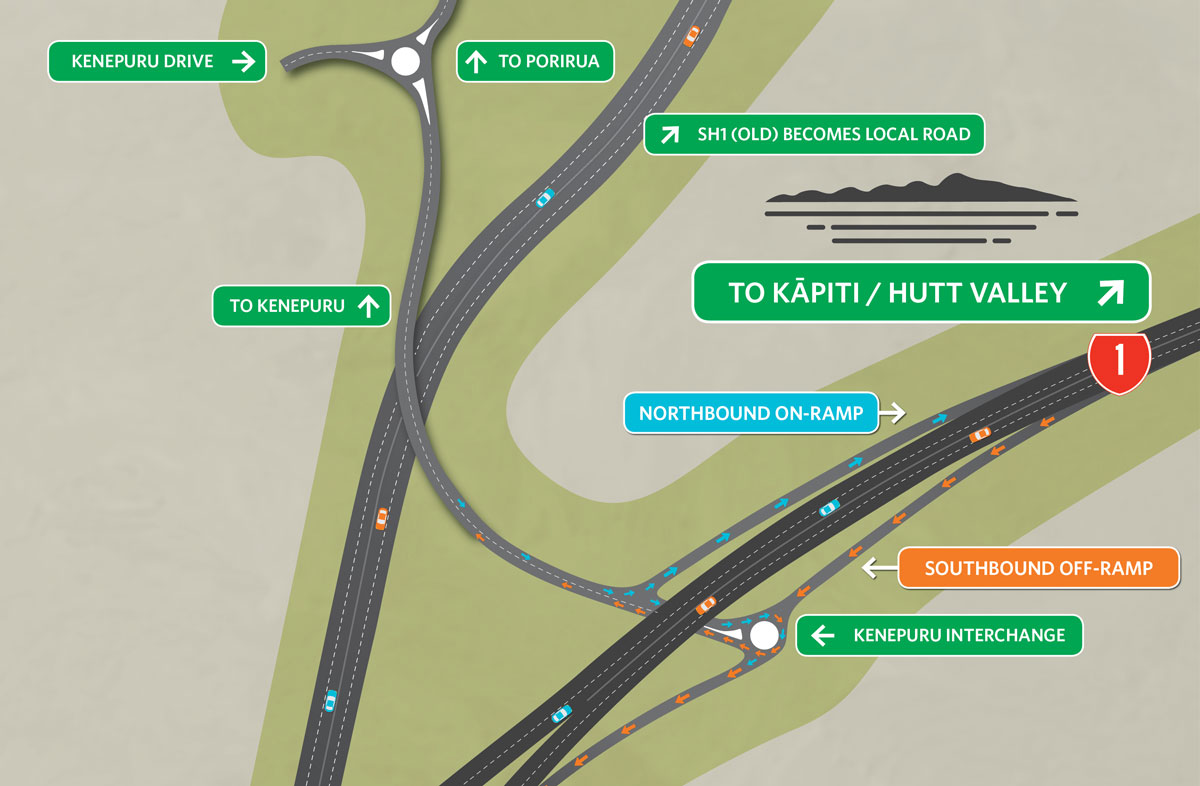
Map view of the new northbound on-ramp from the Kenepuru link road.
Southbound traffic on Kenepuru Drive will have two choices when they reach the new Kenepuru Drive roundabout.

Map view of the new Kenepuru Drive roundabout and link road to the Kenepuru Interchange.
Southbound traffic on Transmission Gully motorway can take the off-ramp to the Kenepuru Interchange to connect with Kenepuru Drive for Linden, Tawa or Porirua connections.
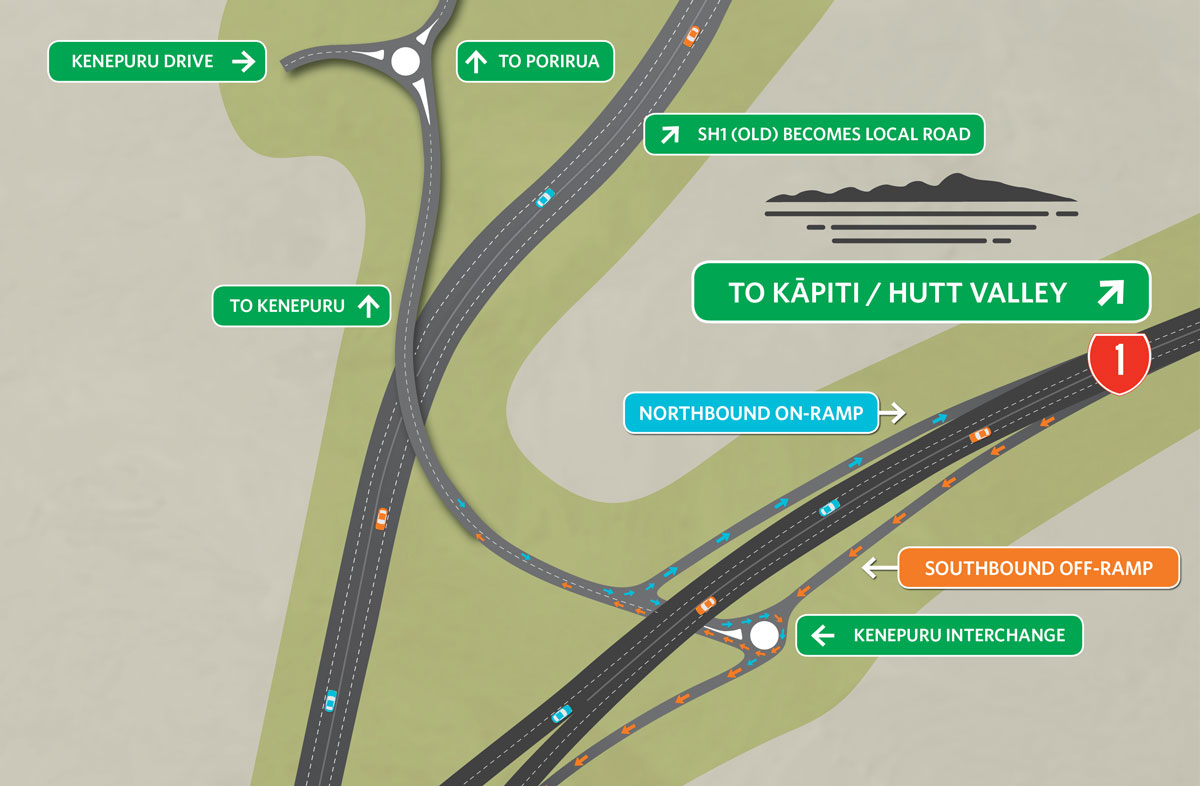
Map view showing the off-ramp to the new Kenepuru Interchange and link road to Kenepuru Drive.
Southbound traffic from Porirua and other northern suburbs on the existing SH1 will merge with southbound Transmission Gully motorway traffic just south of the Kenepuru Interchange and continue southbound to Wellington.
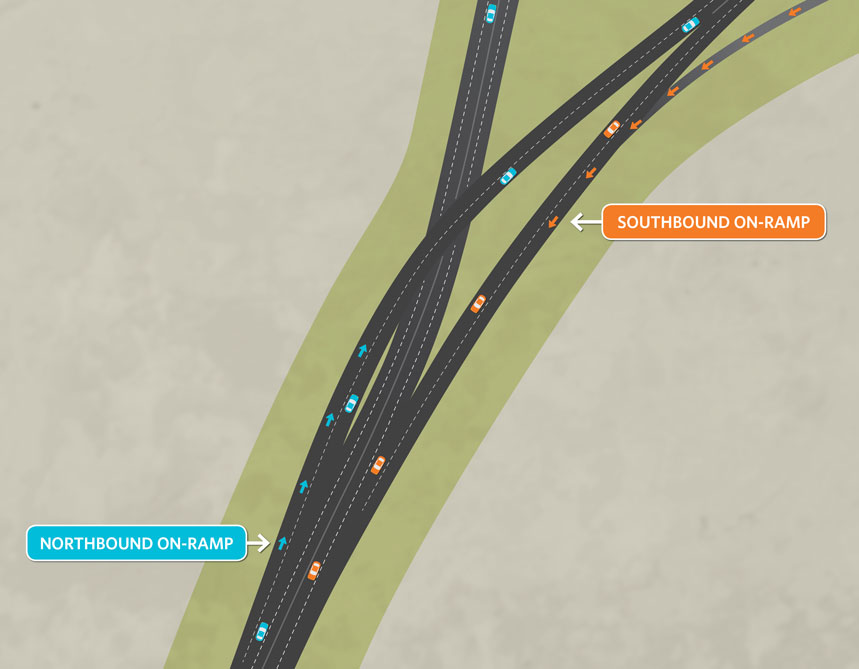
Map view of the Kenepuru Interchange southbound onramp showing the southbound merge
Check out the animated video below to see the new Kenepuru Interchange in action.
With more than a million native trees and shrubs now planted across the project, the area is one step closer to creating one of the most significant lowland bush areas in the Wellington region.
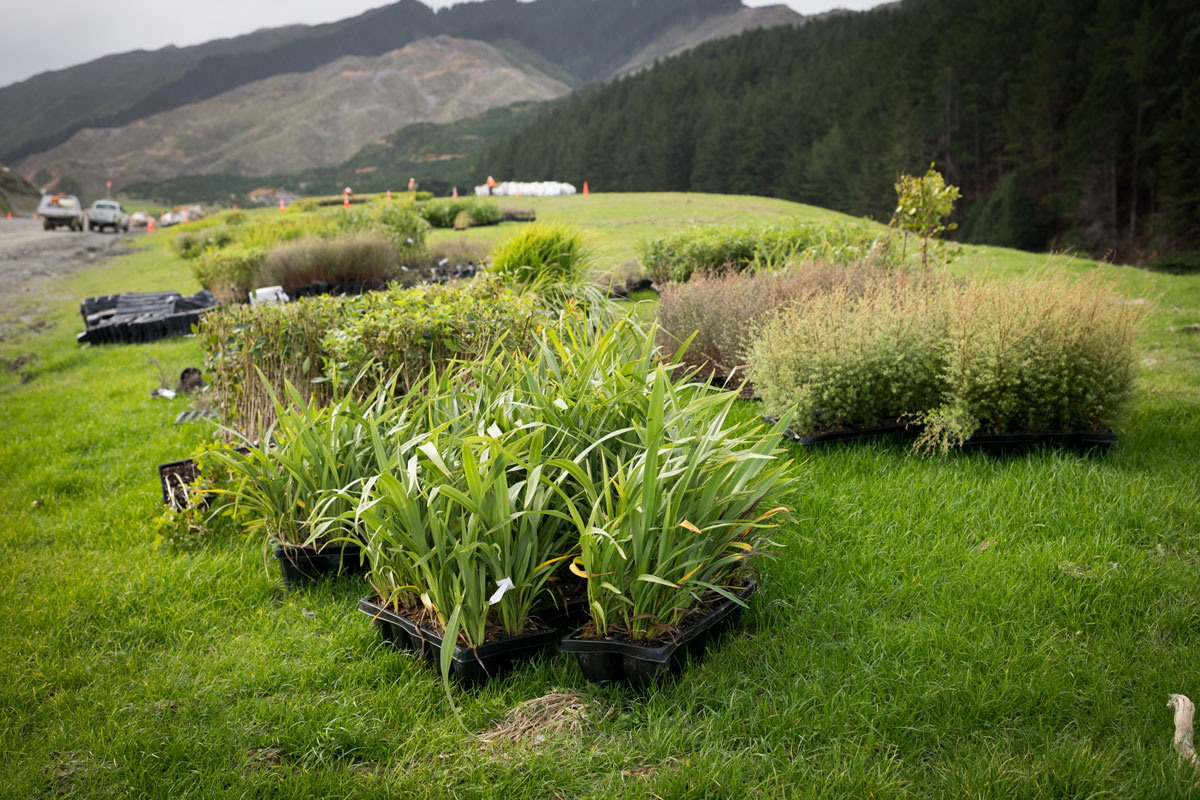
Native trees and shrubs ready for planting near Battle Hill Farm Forest Park.
Around 534 hectares of land surrounding the new motorway is coming to life, with a variety of new seedlings, including long-living giants like tōtara, mataī and rimu. It’s expected that the increased habitat will see iconic song-birds like tui and bellbirds successfully nest in the new bush and hopefully rarer species like native falcon or karearea and kaka may migrate from the Tararua, Remutaka and Akatarawa Ranges to and from sanctuaries like Kāpiti Island.
In addition to the one million tally to date, there is also an extensive road-side planting programme underway on the banks and batters around the Porirua-Tawa, Pauatahanui and Paekākāriki areas.
Planting contractor, Evergreen Landcare, has 50 years experience of working in New Zealand and has led the reafforestation programme for Transmission Gully motorway since 2017. By the end of the construction, they will have planted about 1.5 million native trees and shrubs. All seeds have been ‘eco-sourced’ from Wellington, the Kāpiti Coast and the Akatarawa Ranges, as well as from the Transmission Gully motorway route. They are all local species that are known to thrive in this region.
Evergreen’s Contracts Manager Ben Hine says he’s proud of the planting team, involving around 12 full-time members, working each planting season (April to September) in rugged terrain and all weather conditions.
“A typical day runs from dawn to dusk, often they are first in and last out”, says Ben.
More than 40 percent of the plants have been delivered by helicopter, using Kāpiti Heliworx, partly because of the steep slopes, but also to save time and prevent unnecessary injury or fatigue from carrying heavy seedlings overland. A helicopter can cart between 1000 and 1800 plants at a time.
“The hauling skills of the pilots at Heliworx make a huge difference,” Ben says. “They’re great at identifying challenges and risks and and have a great safety record and management approach.”
The main source of plants is Palmerston North-based Kauri Park Nurseries who specialise in supplying large-scale projects. Reafforestation of Transmission Gully is one of the largest native planting programmes undertaken in New Zealand as part of a construction contract.
Wellington Gateway Partnership’s CEO, Sergio Mejia says a project this size has its challenges.
“To implement such a large planting project requires a collaborative approach with an experienced contractor. The construction JV, CPB HEB, has a strong working relationship with Evergreen Landcare which has been integral to the delivery of this project.”
The planting programme is one of several parts of the motorway project contributing to Greenroads Certification, an international sustainability rating system for social, corporate and environmental responsibility. Credits cover areas such as habitat conservation, community engagement, health and safety and archaeology.
Sergio says that the Greenroads Certification considers five key areas – environment and water, materials and design, construction activities, access and livability plus utilities and controls. “A big part of the project is about achieving good long-term environmental outcomes. We’re focused on ensuring the construction footprint is minimised and offset by many environmental improvements. In the long term, the surrounding environment will be in a better state than before the motorway was built.”
Spring has well and truly arrived, and across the project large sections of the new motorway are ready for final paving. A busy winter season for our planting team has found hundreds of thousands of native seedlings new homes, and a massive 82 percent of the project’s structures are now complete, with the remaining few in their final stages of construction.
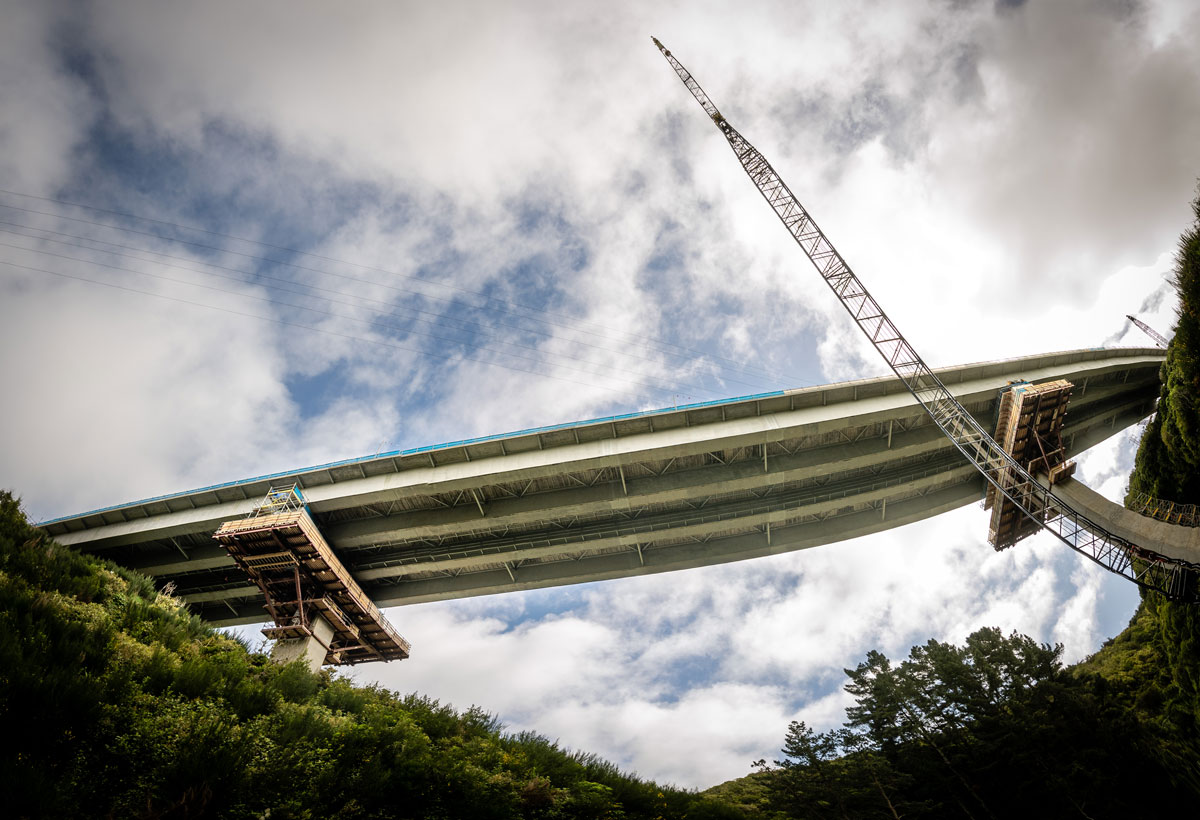
A panoramic shot of the impressive Bridge now spanning Cannons Creek, taken from the gully below.
Here’s an update from the team about what’s been happening, and what’s coming up on the Transmission Gully motorway project.
Paving works are now largely complete for the bridge that makes up the Paekākāriki Interchange,. . Works continue to install the Intelligent Transportation System (ITS) and lighting, and finish the last of the drainage works. Planting through the winter months has been successful, with planting ongoing until the end of spring.
We’ll be profiling the motorway’s Intelligent Transportation System in more detail in our next project newsletter.
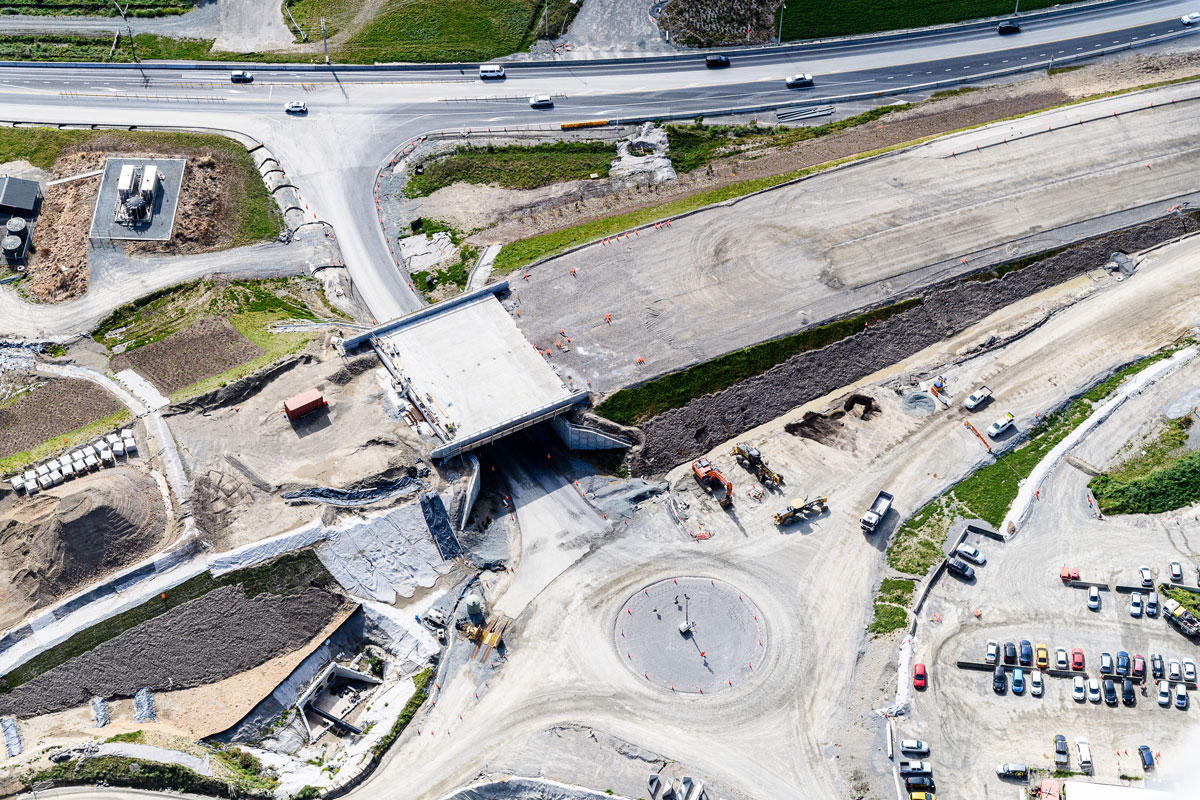
View looking over the Paekākāriki Interchange, where paving works are nearly complete.
Construction of the Mackays Crossing Intersection, located beside the North Island Main Trunk railway line continues. Early next year we’ll be switching SH1 traffic (north and southbound lanes) onto a section of the new alignment to allow the team to finish the intersection and how it ties in to the new motorway. We’ll update road users on these plans closer to the traffic switch.
Through Battle Hill Farm Forest Park, the focus over winter has involved preparing the new motorway alignment for final paving, including installation of subsoil drainage. The team is now ready to install subbase and basecourse material ahead of final surfacing.
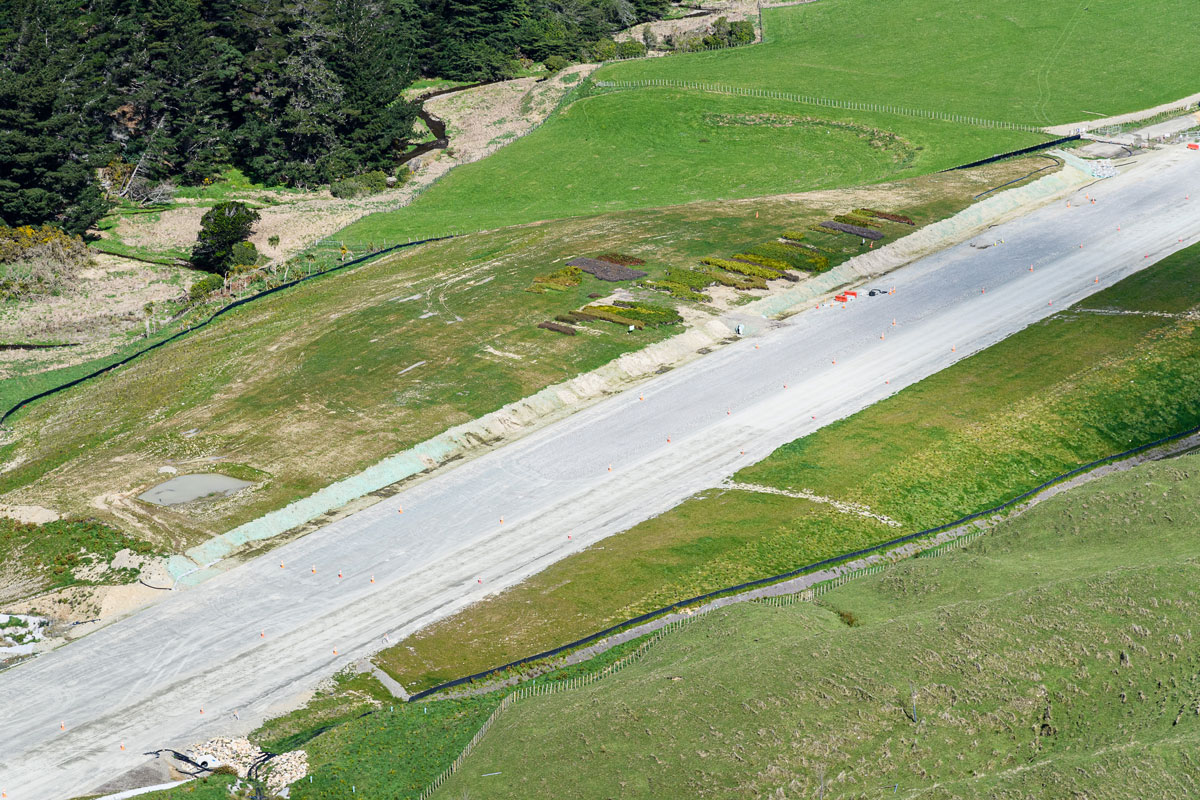
Aerial view looking down on a section of the new motorway at final paving level.
South of Battle Hill Farm Forest Park, the team had a productive winter season, with 85 percent of the new motorway alignment through this area at subgrade level. Construction works for one of the bridge’s in this area is also complete, along with ITS installation and subsoil drainage. Through spring, the team remains focused on completing construction of another bridge in the area, continuing with subsoil drainage works, ITS installation, and subbase material.
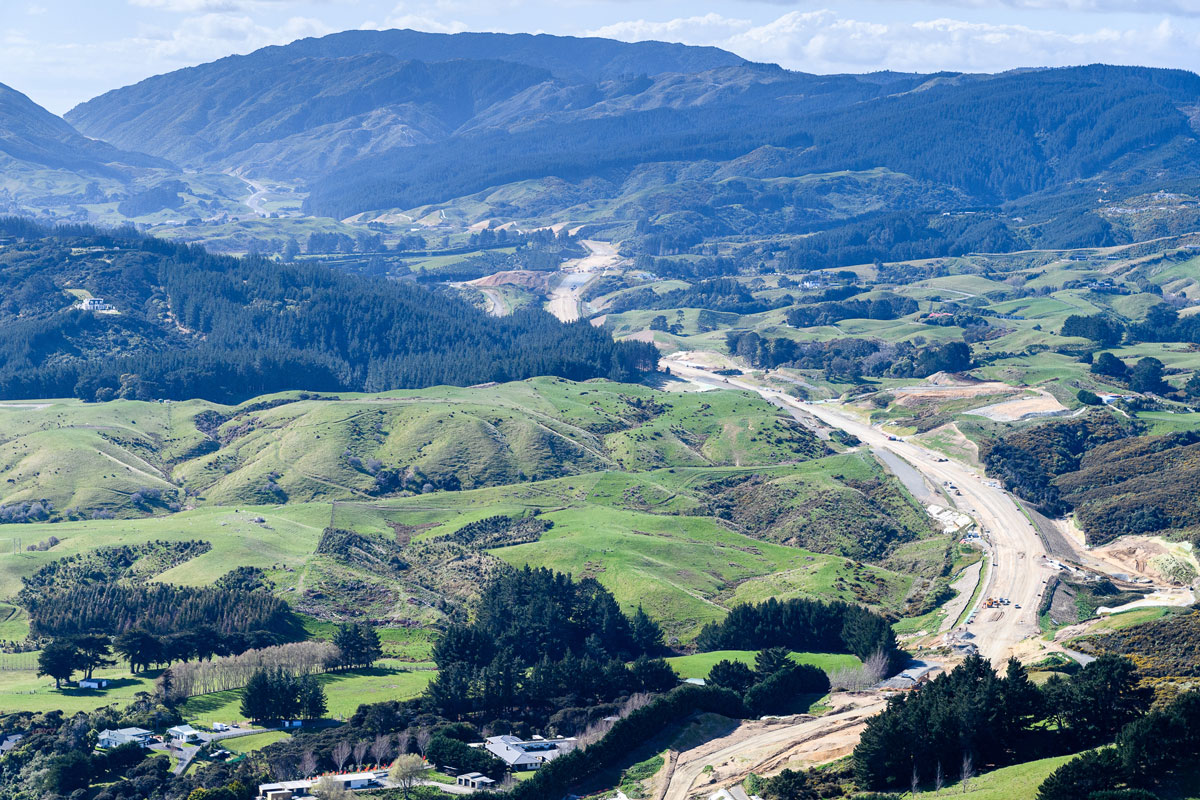
Aerial view of the section of new motorway heading north from SH58 towards Battle Hill Farm Forest Park, which is now at subgrade level.
The four new bridges for the SH58 Interchange are now complete, and the team is underway with works to tie in the local section of Paremata Haywards Road to the new alignment. Along the alignment South of SH58, the team are focused on completing the final sections of earthworks. Works are ongoing to construct a new intersection between Flightys/Murphys Road and Mulhern Road on SH58. This new intersection will provide safe access for trucks from the reopened Willowbank Quarry, to cart materials to site between 10am and 3pm only on weekdays. Once complete, this intersection will remain permanently, for use by vehicles accessing the Willowbank Farm property and the adjacent Judgeford Kennels and Cattery.
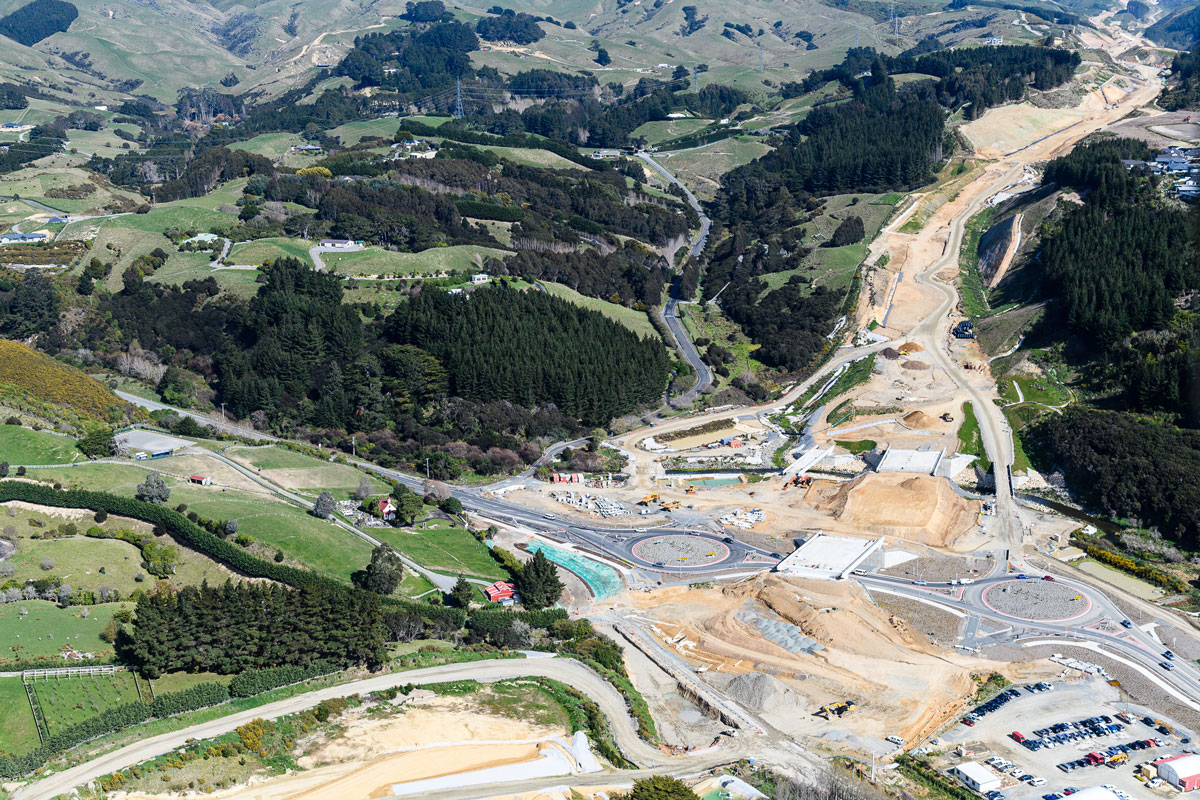
Aerial view looking over the SH58 Interchange. You can now see where the new motorway will head south behind Whitby, towards Cannons Creek.
Construction of the James Cook Interchange is now largely complete, the area is at subgrade level, with drainage works done. Through spring, works will get underway to install ITS, and prepare the area for paving works, including installation of subsoil drains and starting sub-base construction.
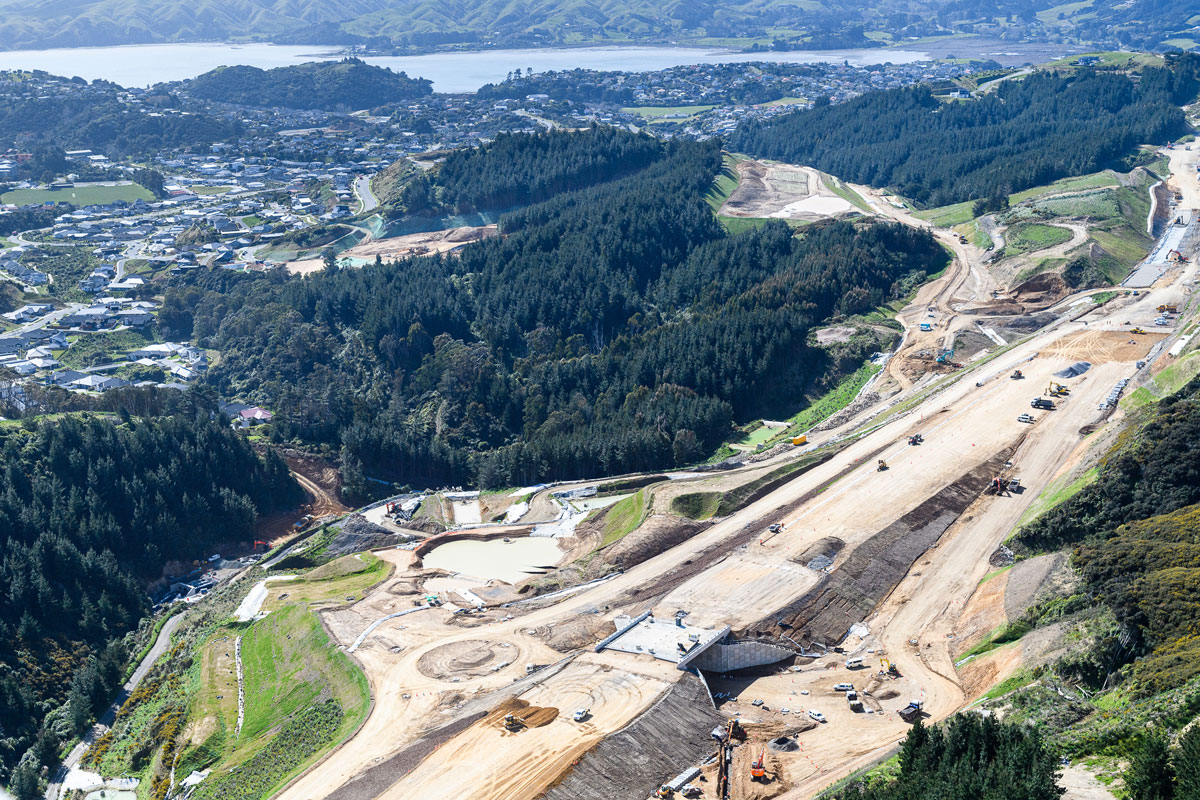
Aerial view over works underway at the James Cook Interchange, where the north and southbound on and off-ramps are taking shape.
The team had a productive winter season, with earthworks continuing where weather allowed. Construction works are in full swing to build a large noise wall next to Maraeroa Marae, which is now 70 percent complete. An impressive structure, the team will paint the wall as construction progresses. More than half the landscaping and planting of the batters is complete and continues through spring.
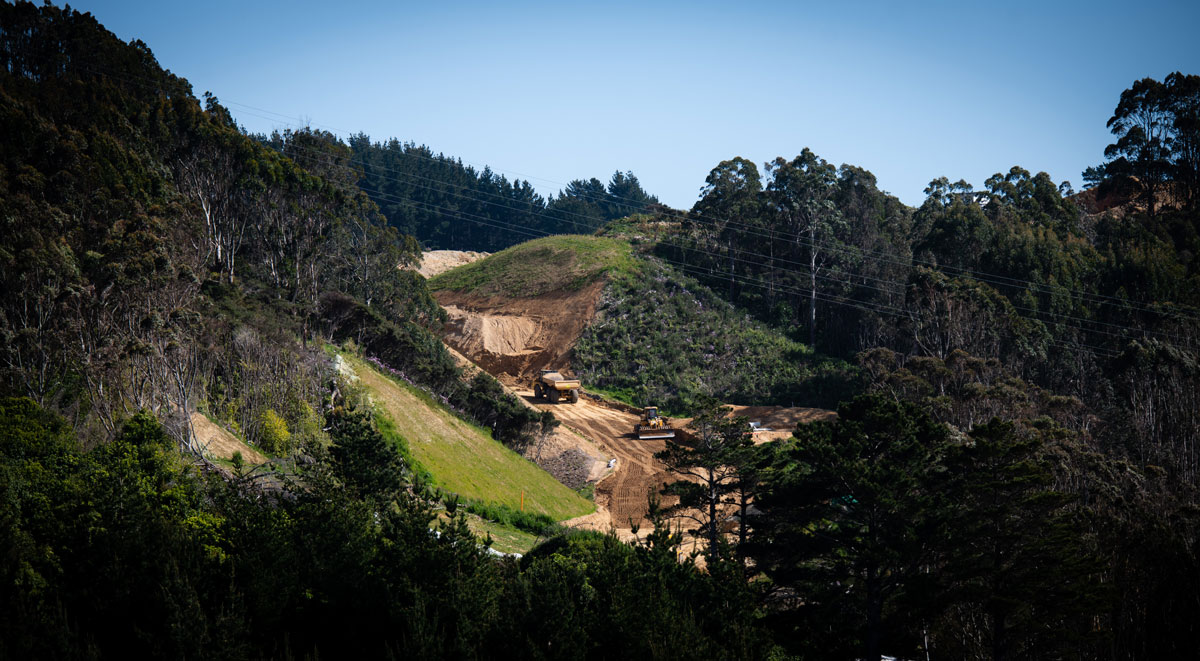
A close-up view of plant machinery working on the Waitangirua Link Road.
The focus for the team through spring will be on bulk cut to fill and subgrade preparation, with the heavy machines returning to site. Pavement drainage installation will get underway, followed by the start of laying pavement and cement stabilisation of the link road later in spring. Please take extra care when traveling through the Waitangirua area, as there will be truck and trailers entering site from Warspite Avenue. We will try to keep these truck movements to a minimum.
Over 40 percent of the landscaping and planting was completed in this area over winter. Drainage and culvert works are now underway, with earthworks also a focus through spring. Pavement works will follow this, with the paving crews working their way from Waitangirua to Whitby where they will meet at the James Cook Interchange.
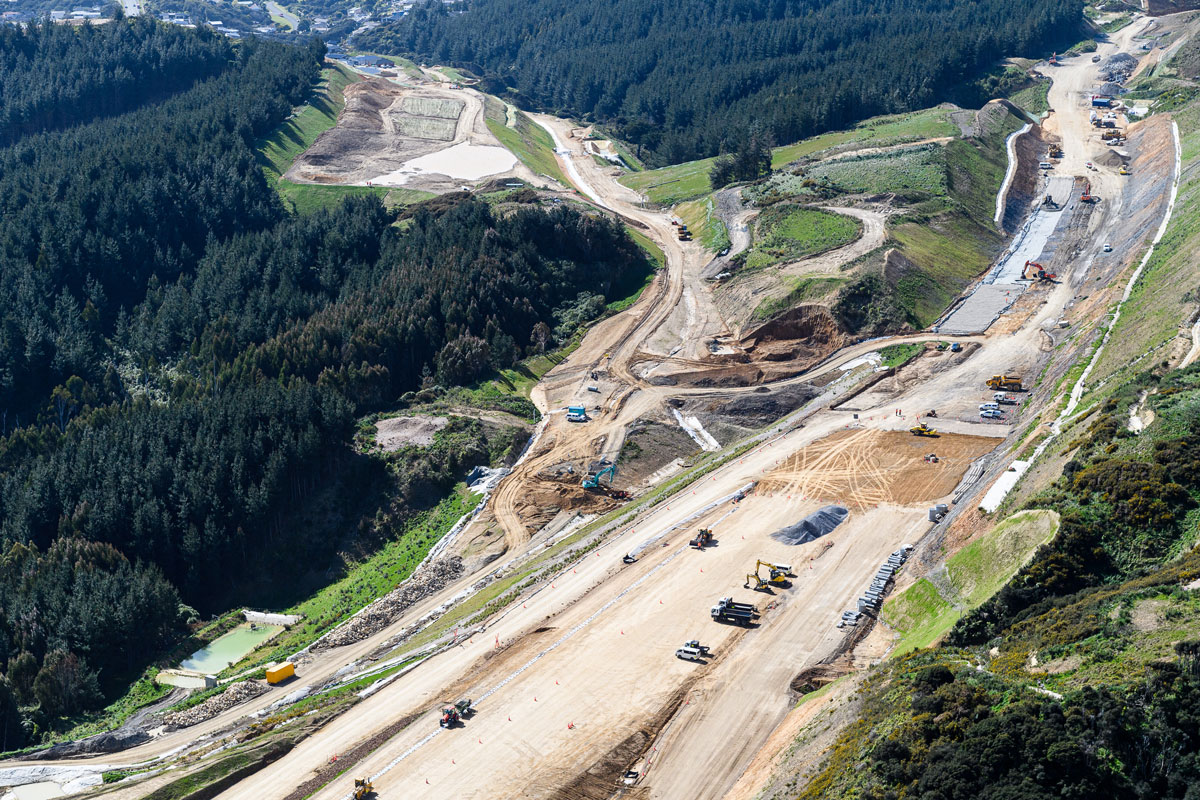
The Whitby Link Road can be seen to the left, where it then heads towards Whitby to the top left of the image.
The link roads are being constructed by CPB HEB JV for Porirua City Council under a separate contract, and will provide the community with access to the new Transmission Gully motorway once open in 2020.
Visit Porirua City Council’s website to find out more about the link roads project.
Porirua City Council’s website(external link)
A key milestone was achieved for the project in August, with the bridge over Cannons Creek undertaking its final launch to reach the northern abutment. The bridge’s massive temporary bearings have now been replaced with permanent ones, and the remaining temporary fixings are being removed and replaced with permanent fixings. The focus for the team through spring will shift to finishing the bridge deck reinforcing, ahead of concrete pouring.
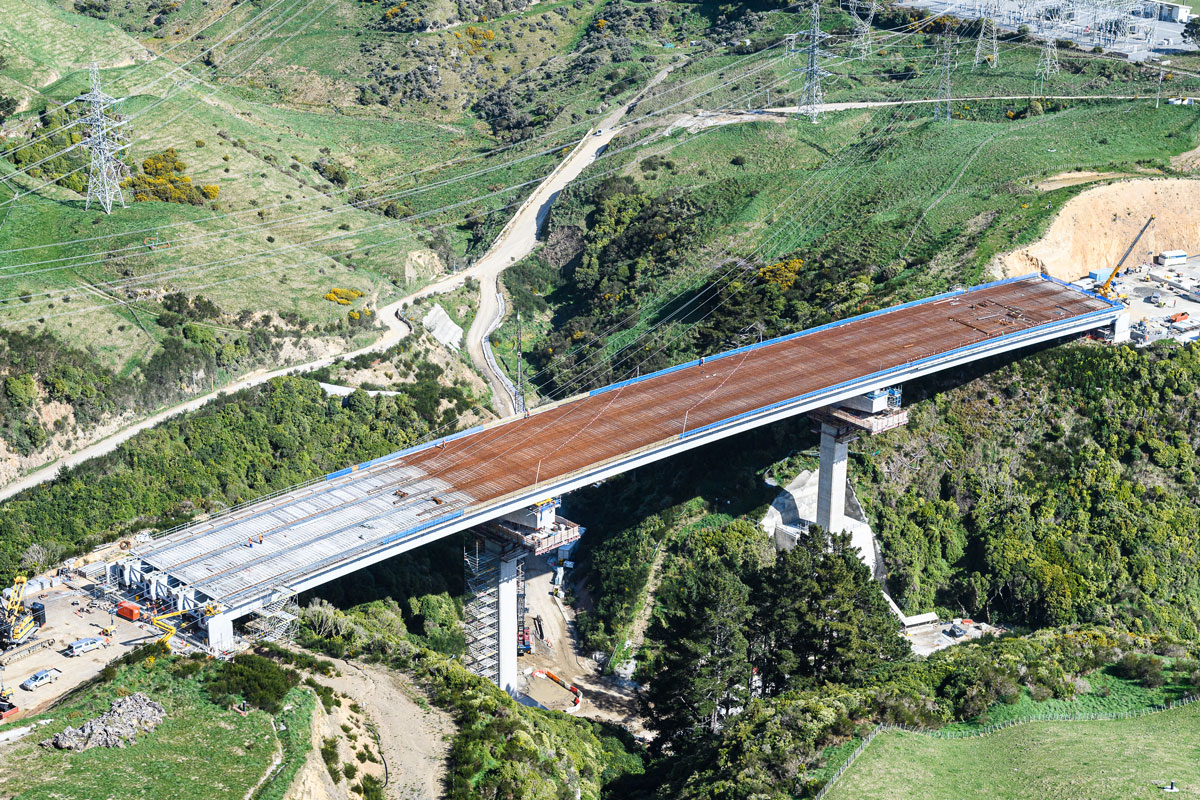
Aerial view looking down on the bridge over Cannons Creek, showing the bridge deck now spanning the width of the gully.
Watch the bridge as it makes its final journey to reach the northern abutment.
Heading south from the Bridge over Cannons Creek towards Kenepuru, the team has been busy through winter installing longitudinal drains, with this work set to be finished by the end of spring. The team is also underway installing sub-base and base course material ready for surfacing works. Landscaping and planting works are in full swing, and will continue through spring.

Aerial view of works underway installing sub-base and base-course south of the bridge over Cannons Creek.
Another milestone was achieved at the southern end of the project, with northbound SH1 traffic moved over onto the new Collins Avenue overbridge in July. This allowed us to demolish the final section of the old Collins Avenue overbridge. The team are now busy with constructing the final northbound section of the new bridge. Through spring, the team will be installing eight new bridge piles followed by the final section of the new bridge. Upon completion, later this year northbound traffic will be switched onto the new bridge. We’ll have more information about this closer to the time.
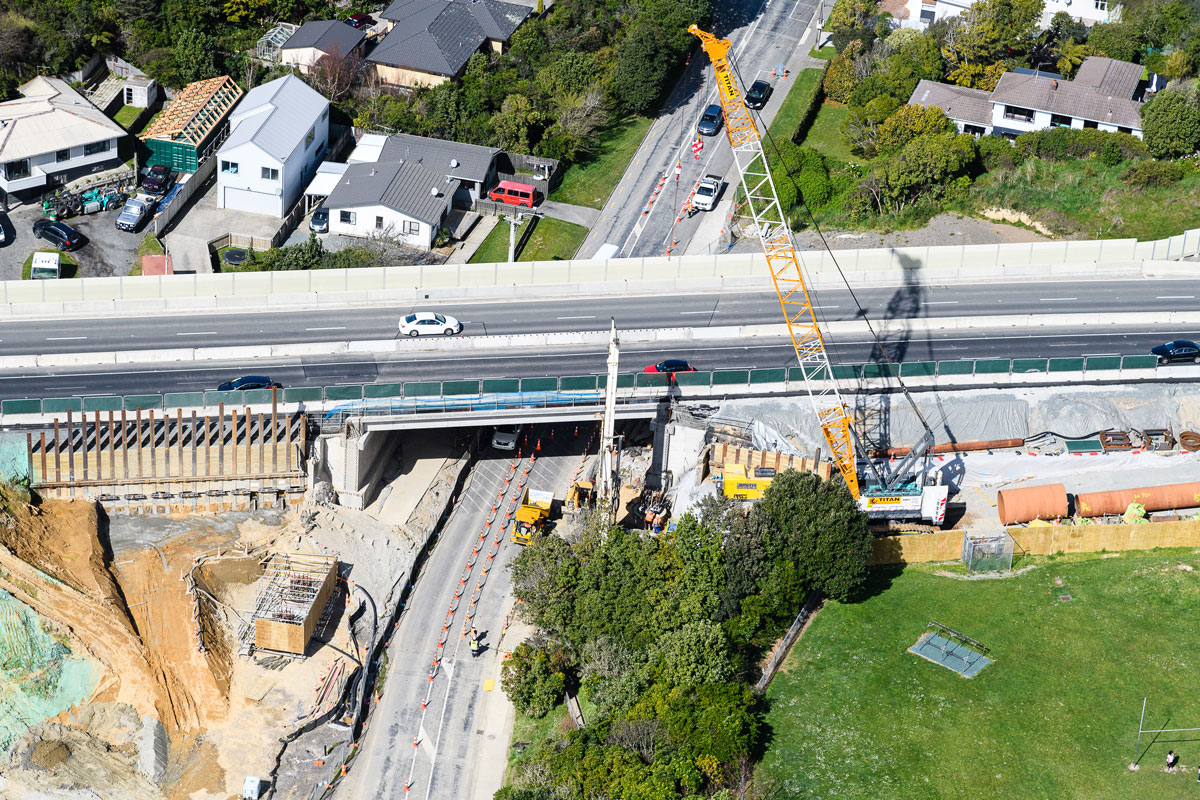
A view looking over the site where the new section of the Collins Avenue overbridge is being constructed.
Watch the final section of the Collins Avenue overbridge being demolished.
Coming up (either later this year or early next) we’ll be installing a signage gantry, that will span the width of SH1 near Linden. We’re working closely with NZTA on the planning for this, as it will require SH1 to be closed in both directions for a period at night, with traffic diverted through Tawa. Once the date for this work has been confirmed, we’ll have information out to road users.
Construction works are also underway for a noisewall on the Western side of SH1, between Tawa College and Linden School. The noise wall will be finished by the end of the year, and once constructed, will be painted (school side) with a mural at a local community event. We’ll have more on this event once details are finalised.
Construction works are ongoing for the new northbound motorway flyover bridge, with final deck pours now complete.
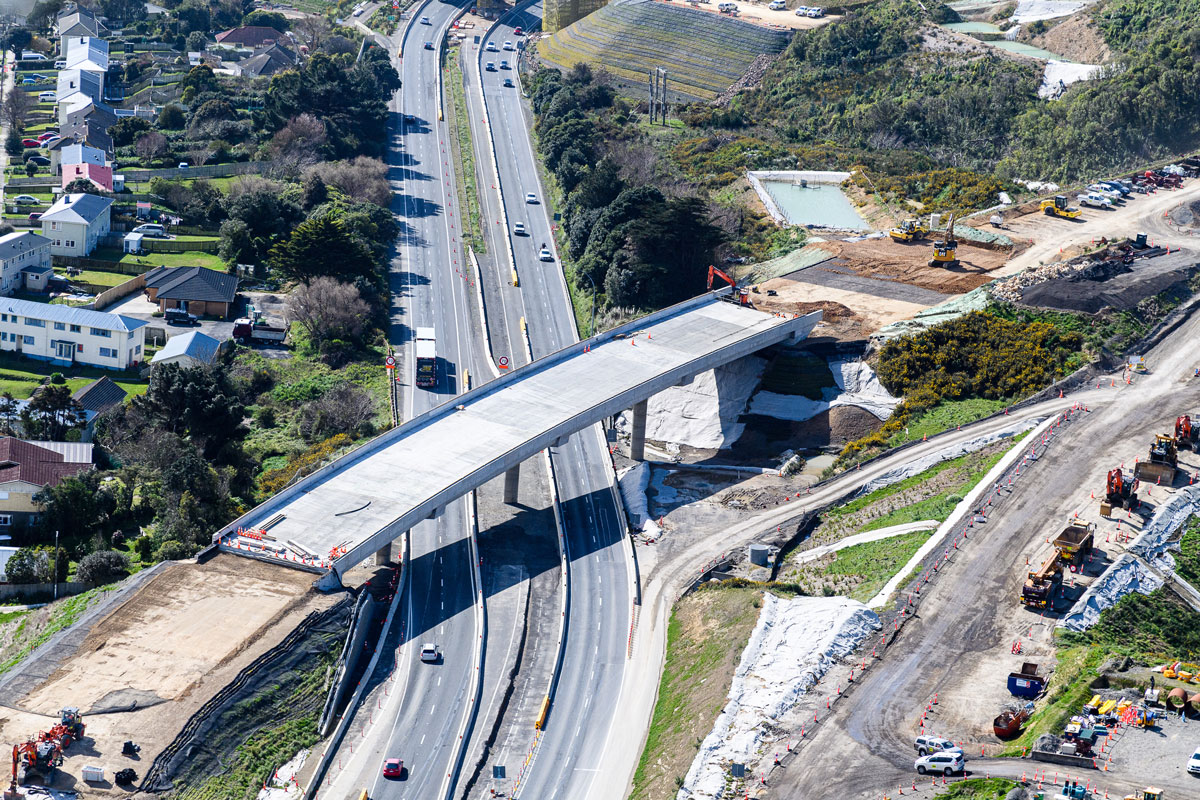
Aerial view looking over the new northbound flyover bridge with completed deck pours.
The team remain focused on the Kenepuru Interchange, with construction works well underway for the southbound on and off-ramps.
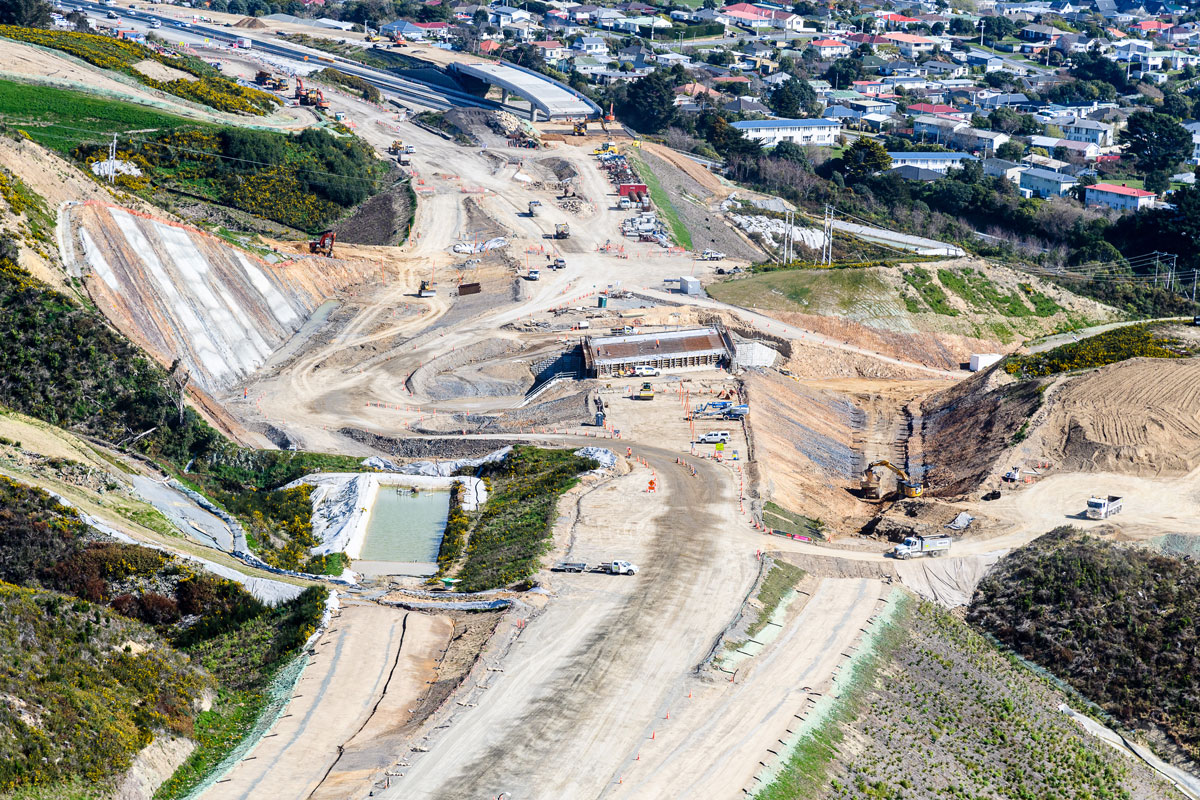
View looking south over the Kenepuru Interchange. Towards the bottom of this image you can see the southbound off-ramp to the left, and northbound on-ramp from Kenepuru to the right taking shape. Looking through the centre of the image you can see the bridge that will carry north and southbound traffic overtop of the Kenepuru link road. And to the far left, this is where southbound traffic travelling on the new motorway will eventually merge back onto existing SH1.
Preparatory works for the Kenepuru Drive roundabout are progressing with ground levels being built up to tie into the local road. This work will start to interface with local road users later in the year, and will involve some temporary traffic management measures. When we are close to starting these works, we’ll update the community on the plans to keep local traffic moving as smoothly as possible. Pedestrians will be provided for as well. Works in the area will be ongoing until the end of the year, to keep us on schedule to open the new motorway in 2020.
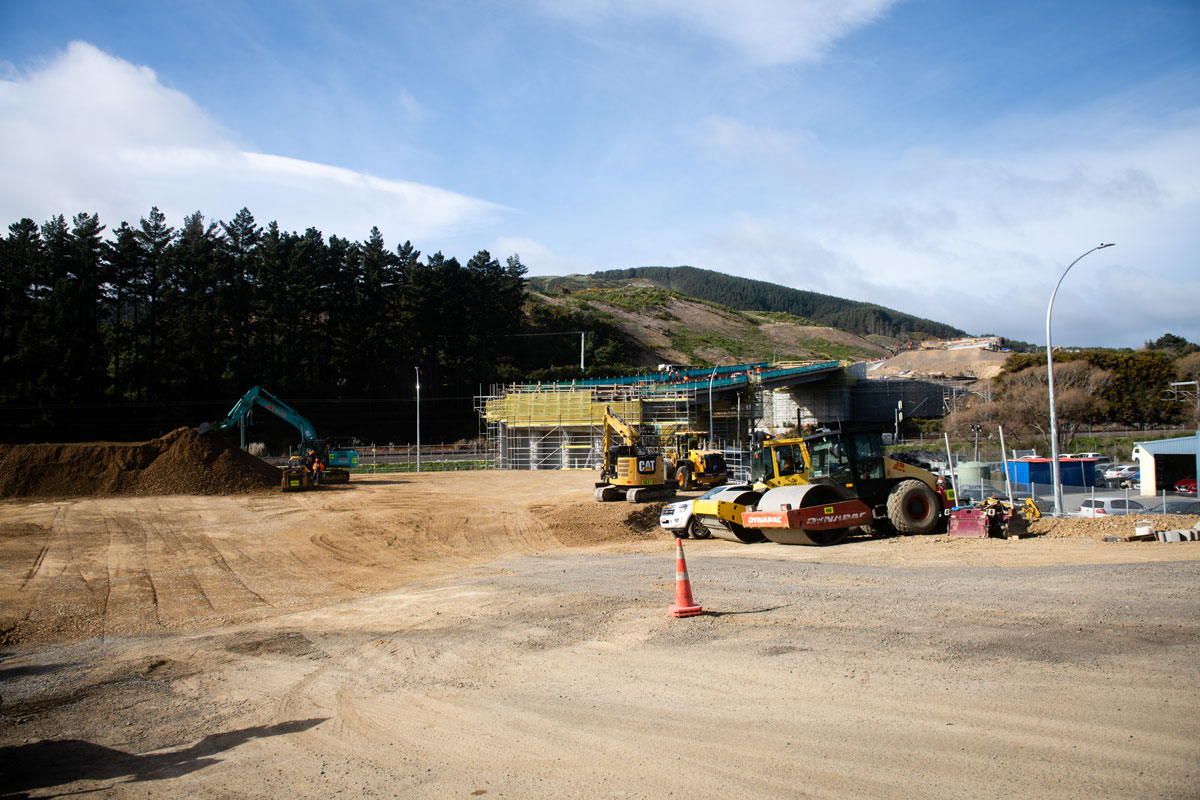
Preparatory works underway for the new Kenepuru Drive roundabout.
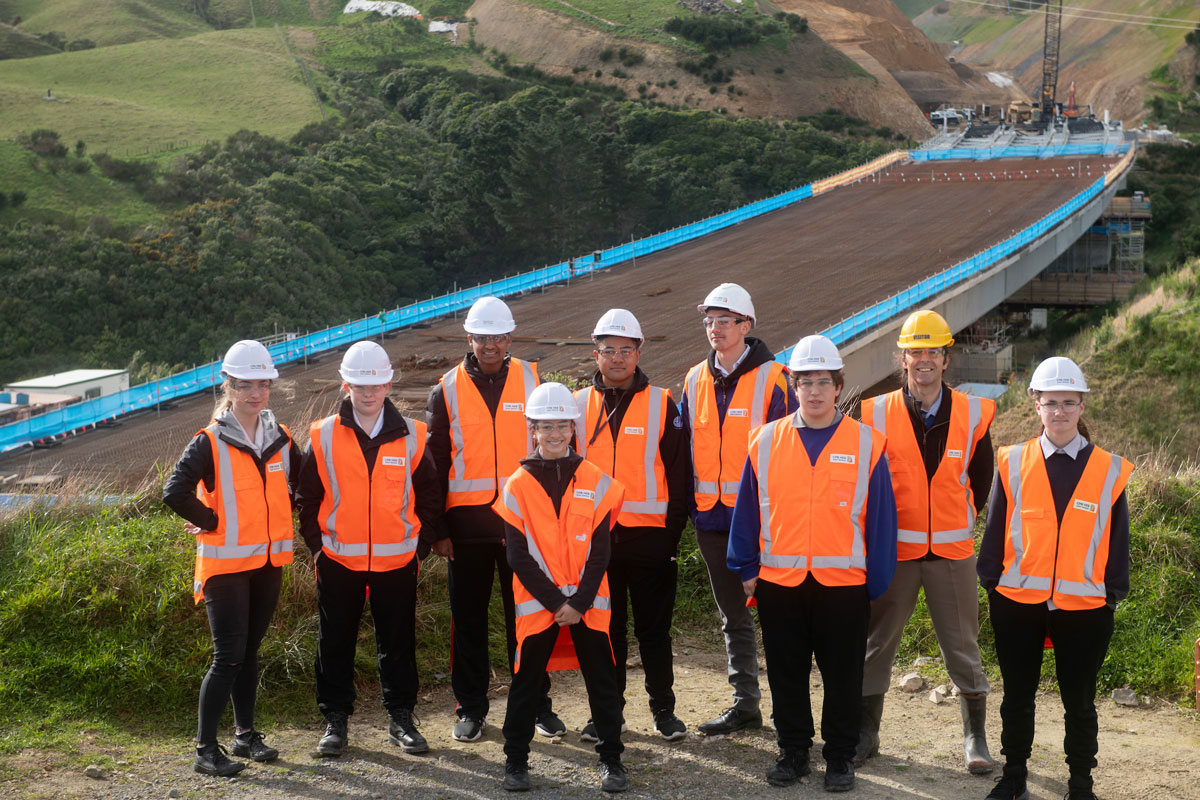
The Tawa College visitors pictured above the the Bridge over Cannons Creek; from left, Michelle Pearson, 17; Maddy Swaine, 17; Rahul Vijayasenan, 17; Anika Park, 13; Raneldo Livapulu, 16; Weston Sao, 16; Ethan de Brouwer, 16; teacher Brian Sturman and Despot Gavrić, 14.
‘Amazing’, ‘impressive’, ‘inspiring’, ‘fun’. These were among the reactions of eight Tawa College students guided through the southern part of the motorway project in August.
Their visit was part of Wonder Week, an Engineering New Zealand initiative to help inspire young Kiwis to enter careers in science, technology, mathematics and engineering. Youngest in the visiting group, Anika Park, 13, who made the ‘fun’ comment, said she liked maths and science and was drawn to building and engineering while playing Lego with her Dad. She was interviewed above the curved Bridge over Cannons Creek – the project’s largest structure - which has been launched incrementally across the gully to land on bridge piers and finally the northern abutment. Asked if the ‘real thing’ had convinced her to study engineering, she replied, “Maybe!”
Despot Gavrić, 14, had the same response. “I’m interested in science and didn’t realise how much physics was involved. Quite a bit more to think about than just construction. If the chance comes up… maybe this would be a useful career.”
Another of the students, Rahul Vijayasenan, 17, was very impressed, adding that the field trip was helping inspire him to pursue his passion for physics, chemistry and calculus at university next year.
Wonder Week takes students behind the scenes of New Zealand’s largest and most successful engineering firms, manufacturers, research centres and tech companies to get a real glimpse of job options. The visit included a presentation by the project’s Zone Manager for Linden-Tawa, on challenges and progress around the Kenepuru Interchange and Collins Avenue overbridge areas. A survey drone was demonstrated by the project’s Survey Manager and GIS Analyst and a general overview of engineering and associated professions was provided by Senior Project Engineers.
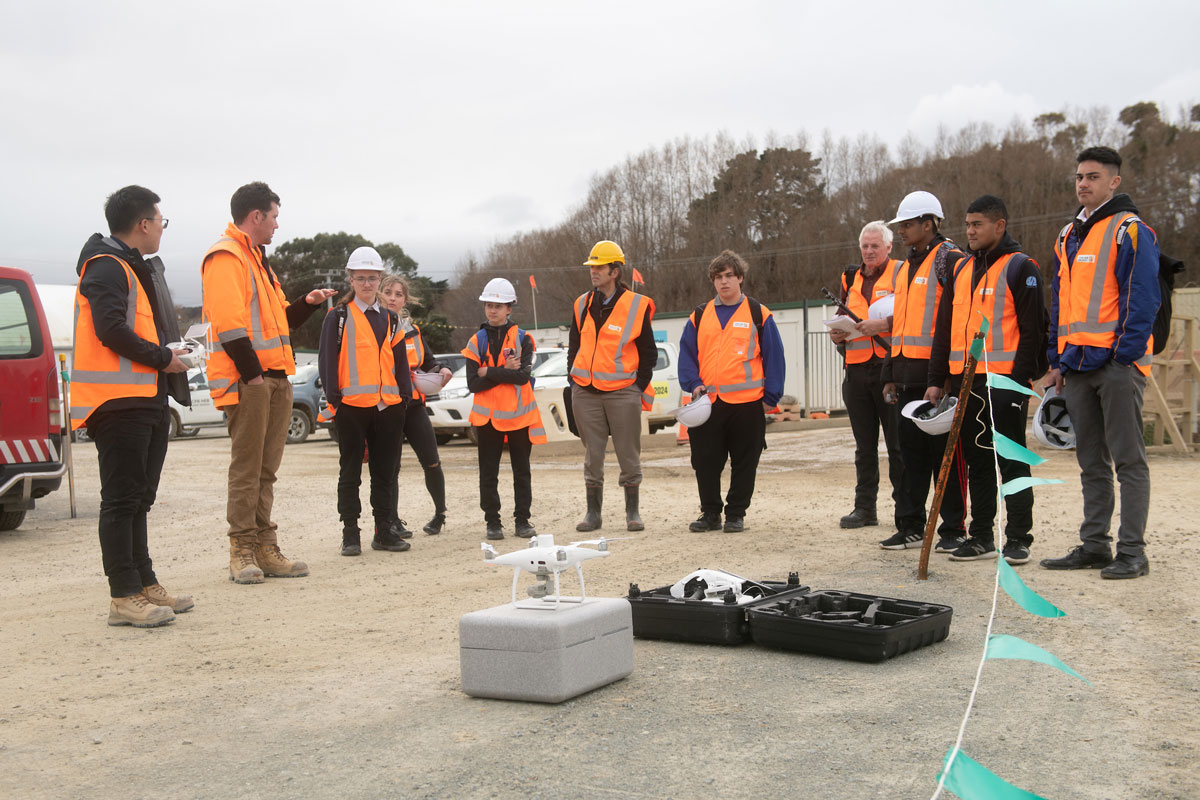
The project’s survey team gives students a drone demonstration and talks through the vital role they play in supporting their work on the project.
“It’s like unveiling fascinating secrets behind Transmission Gully motorway’s building and technology,” says Tawa College Science Teacher, Brian Sturman. “Without hearing and seeing first-hand, we’d have no idea of the amount of thought and effort involved by all, to deliver this massive project.”
Wonder Week joins a long list of mentoring initiatives deployed during the project’s history to employ and train young local jobseekers and enthuse students about further education and opportunities in construction and related industries.

This stunning mural on the project’s mobile visitor centre, was painted by a local artist in 2017.
Residents located on the Western side of the new motorway at Linden, will now see a large noise wall being constructed between Tawa College and Linden School. Initially a blank canvas, once complete the Linden School’s side of the wall is set to be transformed with a colourful mural at a community led event.
The project team is currently talking with the local community and Linden school, to plan an event which will provide the wider community with an opportunity to attend and take part in the painting efforts. A free BBQ, and information stalls will also be there on the day.
Once the details are confirmed, we’ll be sending out more information to the community.
As we move closer to the opening of the new Transmission Gully motorway in 2020, the visitor centre has had its contents updated to give the public an in-depth look at the new interchanges and the next 25-year operation and maintenance phase of the project.
To align with Tawa’s annual ‘Spring into Tawa’ community event, on Saturday 19 October, the visitor centre will be springing into Tawa, and located in the carpark of Simon’s Unichem Pharmacy, alongside the coffee cart.
It will be at this location for the next few months, to give the local community a more in-depth look at the new motorway’s interchanges, and provide information about how to use the new interchanges. There will also be information about Ventia, the company that Wellington Gateway Partnership has contracted to look after the operation and maintenance of the Transmission Gully motorway for the next 25 years following construction, together with some interesting facts and figures covering the construction and environmental areas of the project.
The mobile visitor centre will be open to the public Monday to Saturday from 10am until 4pm, until the end of November. It will then move to Battle Hill Farm Forest Park in December, and be open for the annual Eat, Drink and Be Crafty, and Battle Hill Farm events.
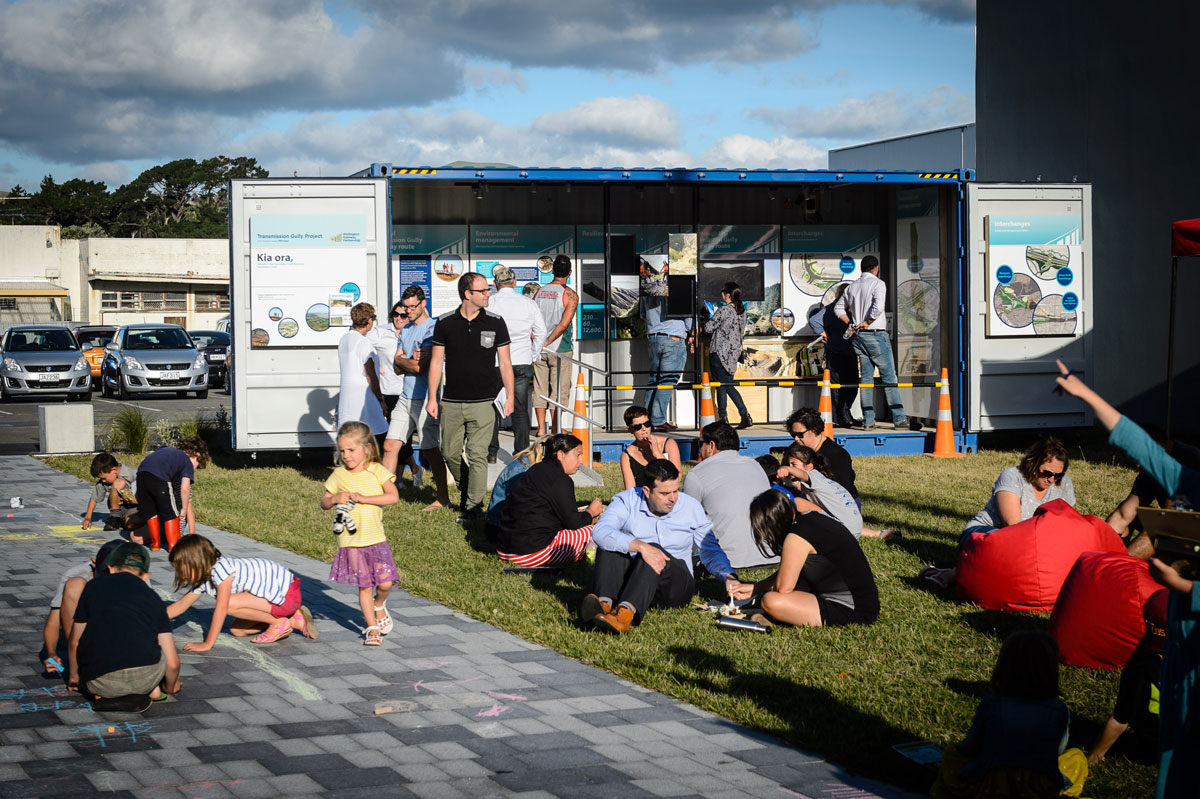
The project’s mobile visitor centre has travelled far and wide with information about the new motorway. Don’t forget to pop in when you’re down in Tawa to check out the newly refreshed information about the project.
Check out the project’s image gallery to view the latest photos of the motorway from the air and on the ground.
Visit our video library to see animated videos of the Interchanges and innovative construction works for the project.
Don’t forget to tell your friends and family to sign up(external link) to receive the latest project news.
We hope you enjoy reading these updates, and we’d love to hear from you. If you have any questions, comments or story suggestions, you can email them to info@tg.co.nz
For the latest traffic updates follow us on Twitter and Facebook: